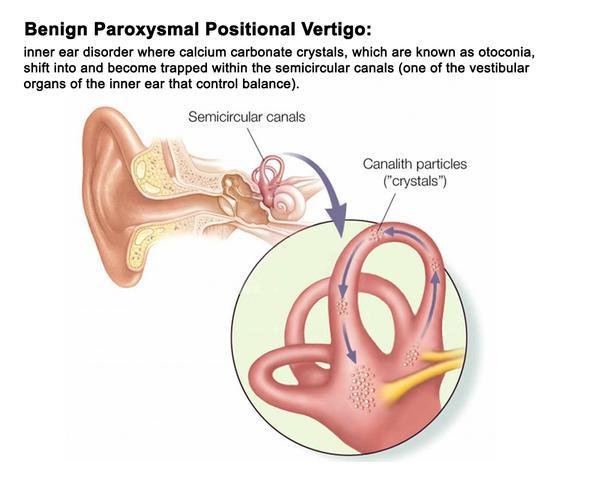Dizziness can be used to describe a wide range of sensations correlating with a sense of feeling off balanced, also known as a sense of disequilibrium. When this dizziness causes the feeling that you or your surroundings are moving or spinning, this can be sub-classified as vertigo. Treatments for dizziness are dependent on both the cause and your symptoms.
Our primarily focus will be on Benign Paroxysmal Positional Vertigo (BPPV). BPPV is considered to be the most common form of vertigo, the exact cause of BPPV is unknown and still under review. However, you can typically tell if you have BPPV if you are experiencing dizziness with changes in position of your head. For example, you might experience an episode of BPPV when you lie down, turn over, or sit up in bed.
To get a better understanding of what Benign Paroxysmal Positional Vertigo (BPPV) means, let’s break it down and define each component.
Benign: not harmful or non-life threatening
Paroxysmal: a sudden onset of symptoms that lasts only a short time
Positional: related to or determined by position
Vertigo: sensation of motion or movement that may cause dizziness or loss of balance
Symptoms of General Dizziness:
- A loss of balance or feeling unsteady
- Difficulty focusing your eyes
- Lightheadedness
Symptoms of BPPV:
- A loss of balance or feeling unsteady
- A sense that you or your surroundings are spinning or moving
- Commonly lasts less than one minute
- Dizziness
- Lightheadedness
- Nausea
- Vomiting
Our ability to balance is due to a combination of our vision, our awareness of our body position and movement (proprioception), and our vestibular system. The vestibular system is the main system that contributes to our balance. This system is located in our inner ear and is able to communicate and relay information to your brain.
Inside of your ear, you have a tiny organ called the vestibular labyrinth. This labyrinth consists of three loop- shaped structures called our semicircular canals and two otolith organs.
The three semicircular canals contain a fluid that moves when you rotate your head, moving tiny hair-like sensors which in turn sends information to your brain about the direction you are moving in. In comparison, the two otolith organs are responsible for communicating linear accelerations of the head (acceleration or deceleration) and your head’s position in relation to gravity. Rather than fluid, otolith organs are covered a gelatin-like membrane the contains tiny crystals of calcium carbonate (otoconia).
These microscopic crystals have been identified as being the primary cause of BPPV. For various reasons, some of which are still unknown, these crystals can break off the membrane and move into one or more of the semicircular canals. Once these crystals are stuck in the semicircular canal, changes in your head position will cause the crystals to send a signal to your brain that you are moving, even though you may not be. This signal confuses our brain, which as a result causes the spinning sensation of vertigo.
It is important to both understand and recognize that BPPV symptoms are caused by changes in head movements and that this spinning sensation last typically less than one minute. Between episodes of BPPV, some individuals may feel mild symptoms of BPPV, while others may feel completely symptom free.
Please keep in mind, BPPV is something that can be treated and will only cause dizziness with changes in head position. BPPV will NOT create a constant dizziness, nor will it affect your hearing, produce a headache or faint feeling, create numbness or tingling, or cause issues in your speaking or movement.

The content used on this post and site are for informational purposes only. The content is not intended to be a substitute for professional medical advice, diagnosis, or treatment. Always seek the advice of your physician or other qualified health provider with any questions you may have regarding a medical condition.
Citations:
Image 1: The inner ear and canalith repositioning. 2018, Mayo Foundation for Medical Education and Research . www.mayoclinic.org/tests-procedures/canalith-repositioning-procedure/about/pac-20393315.
“Benign paroxysmal positional vertigo (BPPV).” Mayo Clinic, Mayo Foundation for Medical Education and Research (MFMER). , 30 June 2019, www.mayoclinic.org/diseases-conditions/vertigo/symptoms-causes/syc-20370055.
Purves D, Augustine GJ, Fitzpatrick D, et al., editors. Neuroscience. 2nd edition. Sunderland (MA): Sinauer Associates; 2001. The Vestibular Labyrinth. Available from: https://www.ncbi.nlm.nih.gov/books/NBK11130/

